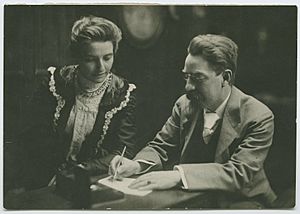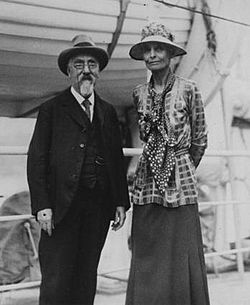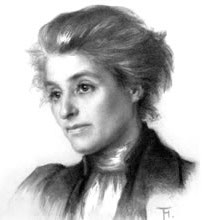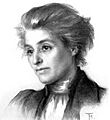Beatrice Webb facts for kids
Quick facts for kids
The Lady Passfield
|
|
|---|---|

Webb, photographed c. 1875
|
|
| Born |
Martha Beatrice Potter
22 January 1858 Gloucestershire, England
|
| Died | 30 April 1943 (aged 85) Liphook, Hampshire, England
|
| Spouse(s) | |
| Parent(s) | Richard Potter Laurencina Heyworth |
Beatrice Webb (born Martha Beatrice Potter; January 22, 1858 – April 30, 1943) was an important English thinker. She was a sociologist (someone who studies society) and an economist (someone who studies how money and resources are used). She was also a socialist who believed in fairness for everyone.
Beatrice Webb helped create the idea of collective bargaining. This is when workers join together to negotiate their pay and conditions. She also helped start the London School of Economics, a famous university. She played a big part in forming the Fabian Society, a group that wanted to improve society peacefully.
Contents
Beatrice Webb's Early Life
Beatrice Potter was born in Standish, Gloucestershire, England. She was one of nine daughters of a businessman, Richard Potter. Her mother was Laurencina Heyworth. Beatrice's grandfather, Richard Potter, was a politician who helped create the Reform Act 1832. This law gave more people the right to vote.
Beatrice taught herself many things from a young age. She was inspired by the idea of people working together for common good. She also learned from the philosopher Herbert Spencer. After her mother died in 1882, Beatrice helped her father. She had a relationship with politician Joseph Chamberlain, but it ended because she wanted to be independent.
In 1892, she married Sidney Webb. They had a strong partnership, working together on many projects. Beatrice wrote that they were "still on our honeymoon" even years later.
Pioneering Social Research
Beatrice Webb was very interested in helping people and understanding society. Her older sister, Catherine, was a social worker. Beatrice helped her by collecting rent in Wapping, a poor area of London.

Beatrice also helped her cousin, Charles Booth. He was doing a huge study of the poor areas of London. This work became a 17-volume book called Life and Labour of the People of London. These experiences made Beatrice think differently about charity.
In 1890, Beatrice met Sidney Webb. They married in 1892 and worked together for the rest of their lives. When her father died, Beatrice received money that allowed her to fund her research.
Working with the Fabian Society
Beatrice and Sidney Webb became active members of the Fabian Society. This group believed in making society better through gradual changes. With the Fabians' help, Beatrice wrote books about socialism and co-operatives. These included The History of Trade Unionism (1894) and Industrial Democracy (1897).
In 1895, the Fabians used money from a gift to start the London School of Economics and Political Science. This school became a very important place for studying society and economics.
Beatrice also became a vegetarian in 1902. She even started a vegetarian club for socialists.
Ideas on Co-operative Movements
Beatrice Webb had important ideas about how co-operatives should work. Co-operatives are businesses owned and run by their members. In her 1891 book, The Cooperative Movement in Great Britain, she talked about two types.
She supported "co-operative federalism." This means that groups of consumers should form co-operative societies. These societies would then buy farms or factories to produce goods. She believed this would help consumers.
Beatrice was less keen on "worker co-operatives" at the time. These are businesses where the workers themselves own and control the company. She felt they had not been very successful in bringing about her vision of socialism.
It was Beatrice Webb who first used the phrase "collective bargaining." This term describes how workers negotiate together for better conditions.
Shaping the Welfare State
For four years, Beatrice Webb was part of the Royal Commission on the Poor Laws and Relief of Distress 1905-09. This group studied how to help poor people. Beatrice wrote a special report called the minority report.
In this report, she described what a "Welfare State" should be. This is a system where the government helps its citizens with basic needs. She wrote that it should give everyone a "national minimum of civilised life." This meant enough food and training for young people, a fair wage for adults, and care for the sick or elderly.
William Beveridge, who later created the UK's welfare state in 1942, worked with the Webbs on this report. He also became the director of the London School of Economics.
Later Life and Soviet Communism
In 1928, the Webbs moved to Liphook in Hampshire. Beatrice was worried about the rise of strong, controlling governments like communism in Russia and fascism in Italy. She saw them as "worship of force and the practice of cruel intolerance."
However, after some political disappointments in Britain, Beatrice and Sidney began to look at the Soviet Union differently. In 1932, Beatrice was the first woman to be elected a Fellow of the British Academy.

That same year, Beatrice and Sidney, both in their 70s, visited the Soviet Union. Three years later, they published a very long book called Soviet Communism: A New Civilisation? (1935). Sidney wrote most of the book, using information from the Soviet embassy.
Many historians have criticized this book. They say the Webbs were too trusting of the Soviet government. The book did not fully show the harsh realities of Joseph Stalin's rule. This included forced labor camps (gulags) and purges where many people were arrested or killed.
Even though Beatrice had some private doubts, the book helped create a positive view of the Soviet Union. Later editions of the book even removed the question mark from the title, suggesting they were certain it was a "new civilisation."
Family and Legacy
In 1929, Beatrice's husband, Sidney Webb, became Baron Passfield. This made him a member of the House of Lords. He served as a government minister. Beatrice, however, did not use the title Lady Passfield.
Beatrice and Sidney Webb did not have children of their own. But they saw their projects, like the London School of Economics and the New Statesman magazine, as their "children."
Their nieces and nephews also became important. Beatrice's nephew, Sir Stafford Cripps, became a well-known Labour politician. He was even the British ambassador to Moscow during World War II.
However, not everyone in their family agreed with their views on the Soviet Union. Beatrice's niece's husband, Malcolm Muggeridge, was a journalist. He reported from the Soviet Union and was horrified by what he saw. He strongly disagreed with the Webbs' positive opinions.
Death and Lasting Impact
Beatrice Webb died in 1943. She was cremated, and her ashes were buried in her garden. Sidney's ashes were buried there too when he died four years later.
Later, George Bernard Shaw successfully asked for their remains to be moved to Westminster Abbey. They are now buried there, near other important Labour Party figures.
Beatrice Webb did not live to see the welfare state fully created in Britain after World War II. But her research and campaigning were a huge part of its creation. The welfare state, which provides help for citizens, was a lasting monument to her work. It was first suggested in her 1909 minority report.
Beatrice believed that people who received help from the community should also try to improve themselves. She thought that helping people should lead to better personal character, not just better living conditions.
Archives and Writings
Beatrice Webb's papers, including her diaries, are kept at the London School of Economics. Her diaries are now available online for everyone to read.
Books by Beatrice Webb
- The Co-Operative Movement in Great Britain (1891)
- Women and the Factory Acts (1896)
- My Apprenticeship (1926)
- Our Partnership by Beatrice Webb (1948) - This book covers her marriage and work from 1892 to 1911.
Books by Beatrice and Sidney Webb
- History of Trade Unionism (1894)
- Industrial Democracy (1897)
- English Local Government Vol. I-X (1906–1929)
- The Break-Up of the Poor Law (1909)
- The Consumer's Cooperative Movement (1921)
- Soviet Communism: A New Civilization? (1935) - Later editions dropped the question mark.
Images for kids
See also
 In Spanish: Beatrice Webb para niños
In Spanish: Beatrice Webb para niños






